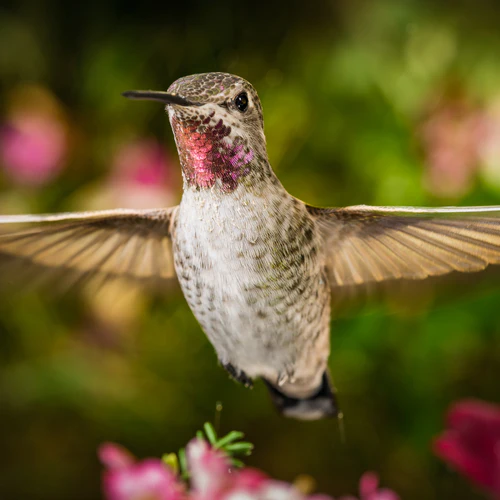Zippy yet delicate, the Hummingbird is always a pleasure to see around the garden or at your window. Hummingbirds are beautifully coloured and quirky to watch – and they’re also fantastic pollinators! In this week’s blog, we’re here to share some exciting facts about our hummingbird friends, what makes them unique, and how you can attract them to your home garden.
Canadian Hummingbirds
Across South America and North America, the Hummingbird can be found in over 300 varieties! However, in Canada, there are five extraordinary varieties that not only call our country home but also our gardens! Check them out below.

Anna’s Hummingbird – Known for their territorial instincts, Anna’s Hummingbird was named after the Duchess of Rivoli, Anna De Belle Massena, for its Ruby coloured neck (males). This particular Hummingbird can reach up to 80 km per hour, one of the world’s fastest animals for its size! Anna’s Hummingbird calls the shoreline of the west coast home, from British Columbia to Mexico.

Calliope Hummingbird – Is the teeniest-tiniest bird that can be found in North America! Weighing just one-tenth of an ounce (about the weight of a penny!) and around three inches long. The Calliope Hummingbird holds the title of the world’s smallest migratory bird. Spending its winters in Mexico and travelling to British Columbia for breeding.

Black-chinned Hummingbird – Unlike most colourful male hummingbirds, black-chinned hummingbird males are noticeably less colourful and often mistaken for females. The distinction, male black-chinned hummingbirds, have a metallic, unique colour-changing violet throat. If you listen carefully, the black-chinned Hummingbird’s wings flapping sounds similar to that of a bee buzzing! These amazing hummingbirds call the interior of the united states west coast home, with minimal breeding grounds in some of Alberta.

Rufous Hummingbird – A uniquely coloured hummingbird with a copper-coloured appearance featuring glowing spikes of green. In this species of Hummingbird, even the females show slight coloration – just less vibrant. Well-known for being territorial, the Rufous Hummingbird is small but mighty and will do its best to scare other birds away from its favourite source of nectar. From Mexico to British Columbia, the Rufous Hummingbird has been known to reach parts of Alaska!

Ruby-throated Hummingbird – The most common Hummingbird found in Canada! With a mouse-like squeak, the Ruby-throat hummingbird can flap its wings more than 50 times in a second! Breeding from Newfoundland to Alberta, down to Florida and across to Kansas! The Ruby-throated Hummingbird knows how to make an appearance!
Attracting Hummingbirds
Hummingbirds are one of Mother Nature’s best pollinators! With their long-skinny beaks, they can access pollen in places that even the bees can’t reach. Introducing pollinators like hummingbirds to your garden is a great way to grow healthy and happy plants by nourishing a solid ecosystem. To reap the benefits these pollinators offer, there are ways to make your garden more attractive for our hummingbird friends.

Colours
You might have noticed that hummingbird feeders are primarily red. This is because red is their favourite colour! Hummingbirds see in the combination of ultraviolet colours, making reds, pinks and oranges highly visible. When planting flowers, aim for bright reds to get their attention.
Feeders
Approaching a highly visible red saucer filled with sweet nectar has become second nature to our hummingbird friends. Before hanging your feeder, it’s essential to know that once these birds are familiar with it, they will come to rely on your feeder for their food source. The feeder will need to be replenished weekly to ensure your hummingbirds get the nutrients they need to survive. To hang your very own hummingbird feeder, try this!

Hummingbird Tray Feeder
1.) To feed your hummingbirds, mix 1 part sugar with 4 parts boiling water and mix until fully dissolved. It is important to use hot water so that any chemicals (such as bleach) are fully evaporated and will cause no harm to the hummingbirds.
2.) Allow your hummingbird nectar to cool down fully before pouring it into the bird feeder. This will prevent any plastic from melting and ensure that the Hummingbird does not get burned.
3.) Once your nectar is cold to the touch, pour it into your favourite hummingbird feeder and hang it somewhere highly visible!
Cleaning Your Feeder – Be sure to always wash your feeder each week! It’s essential to ensure mould does not build up in the feeder, as this can poison your hummingbirds! To prevent mould build-up, look for hummingbird feeders that are easy to clean. Once a week, soak your hummingbird feeder in hot water with mild soap. Use a bottle brush to clean hard-to-get areas, rinse with hot water, and set aside to dry.
Favourite Plants

Above all, our favourite method of attracting more hummingbirds is to plant their favourite plants! Since we’ve been in the gardening industry for over 40 years, we know our stuff when it comes to hummingbird favourites. Throughout that time, we’ve made a few notes that we’ve been asked to share yearly. To help you attract more hummingbirds, check out our list of Hummingbird Favourites here.


